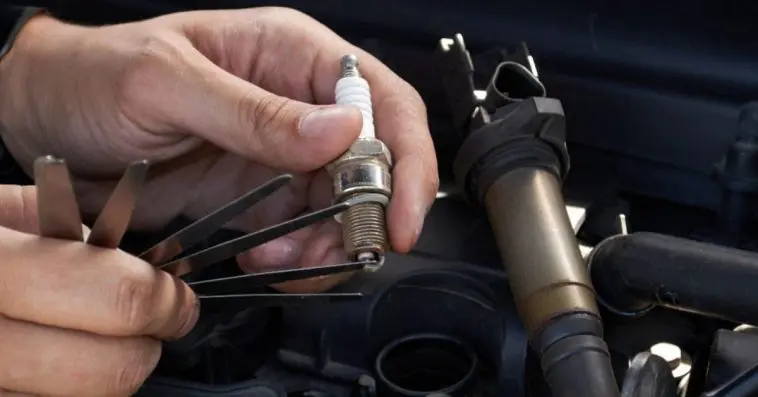Many car owners might know what a spark plug is but few understand the essence of the gap on them.
The gap on the spark plugs play an important role and you need to ensure that it is just the right size before placing it in your car.
For new spark plugs, you can always use a tool to get this done effectively.
Here’s how to gap your park plugs by following the following procedure:
- Get A Gap Gauge Of The Feeler Gauge
- Ensure The Spark Plug Is Clean
- Check The Size Of The Gap On The Spark Plug
- Make The Necessary Adjustments On The Size Of The Spark Plug Gap
- Measure The Size Of The Gap Again
It is important that you know that if the gap on the spark plug is not verified and corrected, you will have to deal with complications.
This is because this might cause cases of misfires and other issues with ignitions that might be costly to deal with.
TABLE OF CONTENTS
Why Gap Matters?
The size of the gap on the spark plug is one factor that should not be taken for granted.
While some spark plugs come with the gap already of the required size, this is not always the case for all of them. Some are interfered with and may not be of the require size.
One of the reasons why the spark plug gap matters is that it determines the effectiveness of the spark created.
The spark is responsible for the correct combustion of the air-fuel mixture which needs to be done in an accurate manner.
You will realize that if the size of the gap differs significantly with the required size complications such as engine misses as well poor starts and hesitation of the engine will be noticed.
Correct Ways To Gap Your Spark Plugs
What Plug Gap Tool Will You Need?
-
- A useful tool that you could use for the gapping of your spark plug is the wire-type gap gauge which can be substituted by a feeler gauge. This will do the trick of measuring the gap on the spark plug.
They will have wires that are of varying thicknesses and you will slip them between the electrodes and confirm the size of the gap on the spark plugs. - Spark plug gauge gap tool might also do the trick.
- A useful tool that you could use for the gapping of your spark plug is the wire-type gap gauge which can be substituted by a feeler gauge. This will do the trick of measuring the gap on the spark plug.
1. Get A Gap Gauge Of The Feeler Gauge
You will need to use these tools to ensure that you get the task done in an easy and effective manner. The gap gauge and feeler gauge will be useful in this procedure.
2. Ensure The Spark Plug Is Clean
You need to clean the spark plug especially if it is an old one that you have been using. Debris on it might cause you to get poor readings of the size of the gap on it.
You should avoid using abrasive materials to clean the spark plug. In the case of a new spark plug, cleaning is not necessary.
3. Check The Size Of The Gap On The Spark Plug
You can then make use of your tools to check the size of the gap of the spark plug, the gap gauge and the feeler gauge will do the trick and you should go for the one that will offer you accurate results.
You can use them by running the tool over the electrodes as you confirm the measurements with that recommended in the vehicle’s owner’s manual.
4. Make The Necessary Adjustments On The Size Of The Spark Plug Gap
If there is a significant difference between the measurement on the spark plug gap and that recommended on the manual, then you will have to make some adjustments.
This can be done by tapping the edge on the l-shaped part or using the feeler gauge.
You can also widen the gap using the same tools until you get your required size in the gap.
You need to be gentle when adjusting the size of the gap as the components of the spark plug are quite sensitive.
When you bend them for more fractions than needed, they may get damaged.
You should note that a lot of pressure damages the components and you might have to get a new one altogether.
5. Measure The Size Of The Gap Again
The next and final step is confirming the size of the gap once again after you have made your adjustments.
You should repeat until you get your required results, while maintaining care not to damage any of the components of the spark plug in any way.
You can also learn how by watching this video:
How To Gap A Spark Plug Without Using A Tool
You might not be able to access any tool that you can use for the gapping of your spark plug. However, you can get this done without necessarily having a tool to work with.
You can do this by following the following steps:
- You should first know the required size of the gap on the spark plugs this varies from one car engine to the other.
You can get the exact measurement of the gap on the spark plug from the owner’s manual of the car.
You can also check for this information from the emissions sticker that is usually in the swingarm. - The next step is getting the coin style gap tool. While working with it, you should be able to see the measurement ramp that is located on the outer edge of the coin style tool.
- You should then position the device in between the electrodes and start rotating it until you sense some resistance.
You should then note at what measurement the gauge is fixed at, this should not be significantly different from the recommended spark plug gap as in the owner’s manual.
If it is differing with that in the manual, you should then adjust it to fit the recommended dimensions. - The gap adjustment is done by simply tapping the plug against the surface until you get the desired size of the gap.
This should be done in a gentle manner to avoid damaging the components of the spark plug.
While doing this, you should be keen not to damage the aluminum insulator or the porcelain on the spark plug by using too much force while adjusting the gap.
These are quite delicate and get damaged with the slightest of force applied on them.
You should also never make use of the ramp to make whatever type of gap, its sole use is measuring the size of the spark plug gap. Using it might damage the components of the spark plug.
Another way is going the hole-gapper way which is not only effective but is quite an affordable way of getting the job done.
What you have to do is simply insert the ground electrode in the hole in the case that the gap is too narrow.
You can then make use of the internal ridge to correct the gap until you get your required size.
You just need to be careful not to exert too much pressure while adjusting the spark plug gap size.
Frequently Asked Questions
Now you know how to gap your spark plugs by implementing the above 2 methods.
You will find out below the information that people also seek when it comes to gapping a plug. I suggest you learn.
Q1: Do Spark Plugs Need To Be Gapped?
Yes, it is important that new spark plugs are gapped. This is because even as they might be gapped in the factory before being shipped, an error might occur through the logistics process.
It is therefore advisable that you check the gap on your new spark plug before installing it and correct it if there is need to.
It is therefore mandatory that both new and old spark plugs are gapped before they are placed back in position.
This is even for those spark plugs that you have just bought and it is written on their packages that they have been gapped already.
You can check on the appropriate size on your car’s owner’s manual.
You should be aware of the fact that spark plug gap size does matter if you want to enjoy your engine providing top performance consistently.
Q1-1: What Happens If I Don’t Gap Spark Plugs?
When it happens that you ignore gapping your spark plugs or that you do not gap them in the required dimensions, then you will notice some complications.
This will be caused by the negative effects that wrongful gapping will cause to the normal functioning of the car engine.
Some of the common signs of a spark plug that has not been gapped include:
- Rough engine condition: You may notice that your engine is quite rougher than it is on normal basis.
They might appear to have an irregular engine idle that is caused by an improper upset of the air and fuel mixture. This then leads to complications with the engine combustion and idle. - Hesitation in the engine: This is the case that the gap is too wide than it is needed to be. You will notice that it frequently hesitates or stumbles when you increase the car’s speed.
- Misses in the engine: This is caused when the poor gapping causes a delay in the engine combustion which leads to misfiring and eventually causing the engine to miss.
- Errors in the working of the engine: For an engine to work well, the components need to be in good condition.
An engine that is performing poorly might be the case because of a poor gapping in the spark plug.
The gap needs to be in accordance to the factory specifications to eliminate the event of inappropriate engine combustion, a weak ignition spark and a delay in the arcing of the ignition spark. - Knocking of the engine: This is an issue that is caused by the complication in the gap of the spark plug.
This is usually the case in the instance that there is an incomplete or delayed engine combustion when you are accelerating.
Q2: What Is The Gap Size For Spark Plugs?
The gap size for most spark plugs ranges between 0.75mm and 0.8mm. You can check on the package which usually indicates the required size of the spark plug.
It is recommended that you avoid taking the size of the spark plug for granted as it determines the performance of the vehicle’s engine when you are driving or even accelerating on the road.
Q2-1: What Happens If Plug Gaps Is Too Big?
When the spark plug gap is too big, there are complications that will arise with the normal working of the engine.
This will be caused because the spark will have a longer distance to travel before firing the spark plug.
When it travels through this bigger distance created by the bigger gap, it loses its heat and makes it quite weak.
You will then start noticing some symptoms such as the car misfiring when ignited. You may also notice some misses when you try to step on the acceleration pedal.
This will be caused by the fact that the gap will be too wide and the working of the spark in the spark plug will not be as effective as it should be.
Q2-2: What Happens If Spark Plug Gap Is Too Narrow?
When the spark plug gap is very narrow the space that is required for the mixing of air and fuel is reduced. This is the room in between the ground strap and the hot strip.
The spark therefore has less distance and time to travel and this does not provide it with the adequate space for charge needed for the ignition of the air and fuel mixture.
When the issue with the spark plug gap is that it is too narrow, you will start noticing abnormalities such as a miss in the car engine, hard starting and a rough idle in the vehicle’s engine.
Most of the symptoms here are centered around the fact that the air-fuel mixture would not be done as needed.
This will then cause the above mentioned issues like the miss in the car engine and the hesitation of the engine more often than usual.
When you take out the spark plug for inspection, you will notice that it is rather dark and that it is wet.
This will then indicate that the gap was too narrow and the dark and wet appearance is because of the incomplete combustion of the fuel.
Q3: How Do I Know If My Spark Plug Is Pre-Gapped?
Some spark plugs come already pre-gapped in the factory, however, through the logistics they gap is interfered with.
That is why you need to check the gap on the spark plug before using it on your car engine.
You can check whether the spark plug you bought is pre-gapped by using a gap tool. For starters, you need to check on the recommended size of the new gap on the new spark plug.
You can then run the gap on the gap tool and if you notice any resistance, you can press on it gently to reduce the gap or use the hole to increase the size of the gap.
For the new spark plugs, you can check on their required gap size on their specs part.
It would be wrong to make assumptions and make adjustments that are not needed. This might turn out to be costly as you will be forced to get a new one altogether.
Q4: Can Wrong Spark Plugs Gap Cause Misfire?
Yes, misfiring is one of the complications that will arise from the spark plugs having a wrong gap. What happens is that the spark will have to travel through a longer distance than needed.
This will deny it its hot and strong ignition charge hence making it quite weak, and thus make it unable to fire up the plug.
This would then lead to a case of misfiring of the engine when the vehicle has been ignited.
As indicated above misfiring may be caused by the size of the spark plug being too big.
When it is too narrow, misfiring might not be the case as the spark will not be able to get its required heat which is actually needed for the spark to actually be effective.
Conclusion
The spark plug is a component of the engine whose function is to ignite the engine’s air and fuel mixture.
This leads to providing the engine with the poor it needs. As such it needs to be in good condition always for the optimum functioning of the vehicle’s engine.
One complication that may make the spark plug unable to do its work is the poor gapping of the spark plug itself.
The gap in the spark plug appears between the side electrodes of the spark and it plays a vital role, which guarantees optimum working of the car engine.
At times the engine is not at its best because of the poor gapping, this is the case when it is either too big or too narrow, and this causes misfiring as well as other issues that prevent the top performance of the engine especially when the driver wants to accelerate.
Sources:
1. Champion Auto Parts – https://www.championautoparts.com/Technical/Tech-Tips/Spark-Plug-Gap-Tip.html
2. RevZilla – https://www.revzilla.com/common-tread/how-to-gap-a-spark-plug




